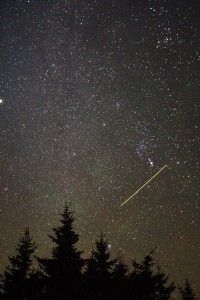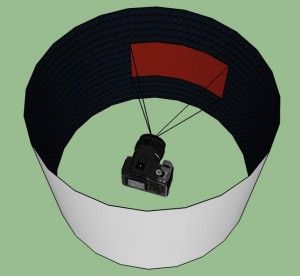Recently I wanted to improve my skills in night sky photographing. So I opened the PC and asked Google a lot of questions. I was reading a lot about shutter speed, focal length and exposure adjustment. A very good site I found was How to Photograph the Milky Way of the site www.lonelyspeck.com. They created a very good tutorial and answered many of my questions. They also created the Milky Way Exposure Calculator, witch lets you calculate how a lens may perform on your camera. For ranking the lenses they calculate a score, basically from the physical parameters of the lens. I agreed with the majority of the parameters, but I was wondering if the slowest possible shutter speed is maybe a bit inaccurate.
In night sky photography the shutter speed is mostly longer than 5-10 s or even more. Without a tracking device the stars will move over the sky and produce, depending on the shutter speed, streaks on the picture. But we want actually a clean image of the stars. So what we need is a lens with a short focal length and an aperture which should have less than f/2 to gather a lot of light. The basics can be checked in the links above. Anyway, the rule of thump for the shutter speed, 500/focal length, seems a bit inaccurate and, as stated there, also not completely usable for APS-C cameras. So I started to think, how can this be solved better…? I was drawing some sketches and made some calculations and concluded: there might be a better and more accurate way: I started to research about what information are available for all lenses and cameras. I concluded that the sensor size and the focal length is available in any case. The angle of view was not all the time available or I just couldn’t find it. Anyway, with the sensor size and the focal length we can calculate the angle of view with the following equation:
In this equation, d is the diameter of the sensor and f is the effective focal length. Since f is depending on the focus, the focal length F of a 50 mm lens is only 50 mm when set to Infinity. Since in astro photography we use only the infinity setting we can assume f = F. So we can also calculate the horizontal and vertical angle of view for a lens. In this case I will just use the stock Canon EF-S 18-55mm 1:3.5-5.6 IS II on a EOS 600D with 18 MP as example. Why we need the horizontal and the vertical angle of view, will be pointed out later. With the pixel count on the camera we can now calculate the angle to pixel ratio. The 600D has 18 MP with a 3:2 ratio. This leads to a pixel count of 5.184 px by 3.456 px. The pixel to angle ratio is calculated by α / Σnpixel. The diagonal pixel count is just calculated by Pythagorean theorem.
- Vertical AOV: αv = 27°; Pixel to Angle Radio = 0,0185°/px
- Horizontal AOV αh = 37.4°; Pixel to Angle Radio = 0,0164°/px
- Diagonal AOV αd = 46.8°; Pixel to Angle Radio = 0,0153°/px
The next assumption we make is that the sky is rotating around the world. I know that some people will now say “NO! Galileo was very clear with that!”. Yes its not true but since we focus anyway on infinity and the sky is more more less a flat area for the lens, this is ok. This lead so my next assumption. The sky is not a sphere, its like a cylinder. The picture demonstrates this assumption. The cylinder rotates with the angular speed of 360° per 24h or 0.00417 °/s. Depending on the pixel to angle ratio we can now calculate the minimum shutter speed. In case of my 18 mm focal length the numbers are very small and and seem not right.
- Vertical max. Shutter Speed: 4.4 s
- Horizontal max. Shutter Speed: 3.9 s
- Diagonal max. Shutter Speed: 3.6 s
But this is only the half truth. Since the stars are not only one pixel big, we can use a threshold. For example a threshold of five pixels will give us five times the shutter speed. In my test, five pixel threshold was mostly ok and not really visible. Somebody who wants to have more clear pictures can reduce the threshold.
- Vertical max. Shutter Speed: 22 s
- Horizontal max. Shutter Speed: 20 s
- Diagonal max. Shutter Speed: 18 s
I’ll program a calculator using javascript in the near future and upload it to this website. Stay tuned!



Pingback: Night Sky Photography Shutter Speed Calculator - tl-photography
Pingback: Milky Way Exposure Calculator – Lonely Speck
Pingback: Night Fox – Night Sky Photography Shutter Speed Calculator Android App | tl-photography
Good job! Back about 3 or 4 years ago Steven Christenson addressed this same problem. He concluded that for a full frame camera (he used a Canon 5D2, 6.4 micron pitch, for his calculations) that the star will move from one pixel to the next pixel in about 5.3 seconds. Thus any exposure over 5.3 seconds does not contribute any additional photons to the image brightness. In reality, I believe that visual acuity must also be considered so a slightly longer exposure covering 2 to 3 pixels (about 10 to 15 seconds) is probably desirable.
Hello Thomas,
I set up a rule that better takes into account the pixel size, the focal length and the aperture of the material, together with the declination angle of the scenery. You can see that (in french but Google will translate it) here :
http://www.sahavre.fr/tutoriels/astrophoto/34-regle-npf-temps-de-pose-pour-eviter-le-file-d-etoiles
It takes into account several factors that allows the exposure time to be increased abouve the fugure you give, such as the effect of the diffraction (Airy disk), of the atmospheric turbulence, and of the bayer matrix on color sensors.
Best regards
Fred
Hi Fred,
really nice article you have there! Very detailed i’ll read it asap with google translate, but an English version would be very cool! 🙂
Best,
Thomas
I tried to follow, but the math was a little confusing to me. I am a pretty good photographer, and self taught with the help of a lot of reading like it seems you have done.
I am sure your numbers match up, but a little over my head. Thanks for the read though.
Cheers,
Julie
Hi Julie,
thanks for your comment. I have sometimes a too analytic approach, i think this is what separates me from a really good photographer…. 🙂
Best,
Thomas
Thank you for the details of your calculations. However I fail to see why there would be a difference between vertical and horizontal orientation since the magnification ratio of the lens is a constant regardless of orientation. The CoC on the sensor due to rotation is determined by the angular rotation per unit time, the lens magnification, and the exposure time. What am I missing?
Hi roger,
with wide angle lenses, the rotation speed on the vertical and horizontal orientation is not the same, since the sensor is not quadratic.
Best,
Thomas
Pingback: Night Sky Photography Shutter Speed Calculator – tl-photography
Pingback: Night Fox – Night Sky Photography Shutter Speed Calculator Android App – tl-photography
I am delighted to find this exploration of calculating exposure / shutter speed. However, it seems to me this calculation is designed to find the exposure time required to avoid star trails.
Can I rephrase the question.
If I have a tracker mount , which avoids star trails, what is the correct shutter speed, for a given focal length and aperture, to provide a good exposure. I define a good exposure as one where the sky or stars are not overexposed. Put another way, I wish to avoid the sky to be overexposed and the stars retain their correct colours (ie stars are not reduced to white dots).
Hi Matt,
thank you for your comment!
With a tracker you should not need this calculator. As you mentioned it’s only for getting a long exposure with a non-tracking mount.
From your comment I understand that you have troubles with over exposed sky. I would recommend:
* Check if the light pollution at the place of your choice is as low as possible. Choose a place where you can clearly see details of the sky, even with the naked eye.
* Avoid moonlight and even the slightest clouds.
* Try first something “interesting” to check the outcome. Like the Milky Way or similar good visible objects. Work your way from there to smaller/dimmer objects.
* Checkout the “stacking” technique. With a tracker that should give you very nice results and software is available also as open-source.
I hope I could help you a little.
Cheers,
Thomas
Hello Tomas,
Thank you for sharing your decent analysis, very nice job.
I now understand that the speed not only based is on the focal length of the lens but also on the camera’s resolution. The only thing is that the result may be different for different resolution camera.
There is another thought to disguard the dependency of camera resolution by replacing it with display media resolution, if the purpose is for display only.
In the case of 1080 media (1920 x 1080), the horizontal speed can be limited to 1pix/1920. For 18 mm lens (90 FOV), this will be
0.0468°/px
The horizontal speed will be 11.25 sec for threshold of 1 pix shift on 1080 media.
Or even to 22.5 sec if the threshold raised to 2 pix shift.
My 1 cent
Wayne
Hi Wayne,
thank you for sharing your thoughts!
You’re absolutely right, the resolution must be taken into account.
In my calculator I consider the resolution with the ‘Megapixel’ and ‘Pixel Tolerance’ fields:
https://www.tl-photography.at/stars/night-sky-photography-shutter-speed-calculator/
Cheers,
Thomas